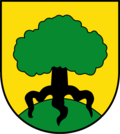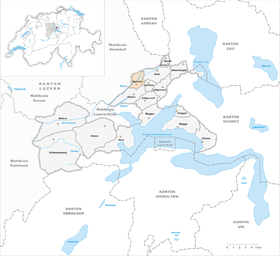Buchrain LU
| LU is the abbreviation for the canton of Lucerne in Switzerland and is used to avoid confusion with other entries of the name Buchrain . |
| Buchrain | |
|---|---|
| State : |
|
| Canton : |
|
| Constituency : | Lucerne Country |
| BFS no. : | 1052 |
| Postal code : |
6033 (Buchrain) 6035 (pearls) |
| UN / LOCODE : | CH BHR |
| Coordinates : | 668 888 / 216 375 |
| Height : | 458 m above sea level M. |
| Height range : | 411–483 m above sea level M. |
| Area : | 4.80 km² |
| Residents: | 6242 (December 31, 2018) |
| Population density : | 1300 inhabitants per km² |
|
Proportion of foreigners : (residents without citizenship ) |
18.6% (December 31, 2,015) |
| Website: | www.buchrain.ch |
| Location of the municipality | |
Buchrain ( Swiss-German : Bueri ) is a municipality in the Lucerne-Land constituency in the canton of Lucerne in Switzerland .
geography
The municipality of Buchrain is located on the eastern foothills of the Hundsrück ridge, nestled between the Reuss and Rontal . The village of Perlen is also part of Buchrain.
The highest point in the community is on the Hundsrücke at 484 m above sea level. M. , the deepest on the Reuss at 412 m above sea level. M.
The municipality of Buchrain borders Emmen in the west, Eschenbach in the north-west, Inwil in the north, Root in the east, Dierikon in the south-east and Ebikon in the south .
population
Buchrain had 312 inhabitants in 1850, then grew sharply from 324 to 701 inhabitants between 1870 and 1880. Until 1960 there was steady moderate growth to 1,395 inhabitants. On the occasion of the census in 2000, 4,976 people were counted. There are now 6,116 people in Buchrain (as of December 31, 2017), including 3,066 men and 3,066 women.

Sources: 1798–1837: Helvetic and cantonal censuses; Federal Office for statistics; 1850 to 2000 census results, 2010 ESPOP, since 2011 STATPOP
languages
88.0% of the residents state German as their main language. In addition, due to immigration, Serbo-Croatian (3.5%), Albanian and Italian (1.8% each) are the next most important languages (as of 2000).
Religions - denominations
Until the founding of modern Switzerland, the population was closed Roman Catholic. This has changed as a result of immigration from other cantons in Switzerland and from abroad. 67.3% of the population are Roman Catholics ; 13.5% Evangelical Reformed ; 5.6% Muslims ; 4.0% Orthodox Christians and 6.3% commitment lots (updated 2000).
Origin - nationality
At the end of 2017 the community had 6116 inhabitants. Of these, 4,985 were Swiss citizens and 1131 (= 18.49%) were people of other nationalities. The largest groups of immigrants come from Germany (191 people), Italy (136), Kosovo (135), Serbia (108), Portugal (48), North Macedonia (44), Bosnia-Herzegovina (38), Eritrea (35), Austria (32) and Turkey (31 people).
Schools, education
The Dorfschulhaus (primary level), Haus Dorfhalde (kindergarten), the ‹Wüesthuus› (kindergarten and music school) and the Hinterleisibach school center (kindergarten, primary school, secondary school and secondary school, opened in 1989) are available for school education. The 4th stage of the Hinterleisibach school center opened on June 2, 2007. This includes a third gym and new cloakrooms, two beach volleyball fields, a skate park, artificial turf, additional classrooms and a new auditorium.
In Buchrain (2017/2018 school year) 125 children attended the seven kindergarten classes in the village, the Dorfhalde, Hinterleisibach and Wüesthaus. The Dorf and Hinterleisibach schoolhouses offered 410 primary school students (in 24 classes) and the Hinterleisibach schoolhouse to 167 high school students (in 11 classes). Students commute to the city of Lucerne to attend secondary schools and the university.
Apprentices based in Buchrain
| School year (2017/2018) |
kindergarten | Primary school | Secondary school, all levels |
Overall |
|---|---|---|---|---|
| Departments | 7th | 24 | 11 | 42 |
| Learners | 125 | 410 | 167 | 702 |
from the community and neighboring communities; Source LUSTAT
Apprentices residing in Buchrain
| School year (2017/2018) |
kindergarten | Basic level | Primary school | Secondary school, level A / B |
Secondary school, level C |
Integrated secondary school |
Overall |
|---|---|---|---|---|---|---|---|
| Learners | 127 | 0 | 422 | 133 | 36 | 6th | 724 |
resident in the municipality; Source LUSTAT
economy
In 2016 there were 278 workplaces with 2,337 employees in Buchrain. The percentage of people employed in agriculture has fallen sharply over the past few decades. Agriculture only offers 2.48% of the workforce (58 people) in 8 companies a professional existence. Today, industry and trade with 69 companies and 1,215 employees and the service sector with 201 workplaces and 1,064 employees are far more important. The largest employer in the community is Wirth & Co AG, a machine and paint shop. In 2000 there were 841 train commuters and in 1977 there were commuters (mainly to the city of Lucerne, Ebikon and the canton of Zug).
traffic
The municipality of Buchrain is connected to public transport by the bus line (Lucerne-) Ebikon-Buchrain-Perlen (-Gisikon-Root) ( VBL line 22). Since the timetable change on December 12, 2004, Buchrain has had its own S-Bahn stop on the Zug – Lucerne line .
The cantonal road from Inwil to Ebikon and the A14 motorway , to which Buchrain has been connected since June 22, 2011, run through the community .
history
Courtyard of the Murbach monastery
The history of Buchrain is over 1000 years old. At the beginning, Buchrain was a dinghof (agricultural property for lease with landlord officials who, among other things, also collected the interest and exercised jurisdiction ) of the Benedictine monastery of St. Leodegar in Lucerne . In 840 the monastery lost its independence and became a provost of the Murbach monastery in Alsace . In 1178, «Buorren» was first mentioned as a village.
Austrian rule
In 1291 the abbot von Murbach ran into great financial difficulties and had to sell his dinghouses to King Rudolf von Habsburg . So Buchrain came under Austrian rule and was assigned to the Vogtei Rothenburg. In 1332 Lucerne joined the Confederation, many Buchrainers sympathized with the Lucerne and fought on the side of the Confederates at the Battle of Sempach in 1386. Buchrain then went to Lucerne together with the Rothenburg Bailiwick.
Trade routes, place of pilgrimage and restaurant
In the Middle Ages, Buchrain was on one of the most important trade routes through Switzerland, which led from the Grimsel and Brünig passes to Lucerne and as far as the Rhine . The castles of Nünegg, Richensee, Hallwil and Lenzburg bear witness to the importance of this trade route . In 1455 the consecration of the Buchrainer church was mentioned in a document, this led to various cloisters in the neighborhood. The patron saint against conflagration, Saint Agatha, was venerated . In 1759 the established restaurant "Adler" was opened with business rights. From 1807 to 1811 a room in the "Adler" was even used as a classroom for lessons . The school chronicle reports that Buchrain owned one of the oldest village schools in the canton of Lucerne.
Industrial development
August Bell, machine manufacturer, started an industrial development in Buchrain in 1862 with the construction of the Reuss Canal and the Perlen power station . Factories were built, a wood pulp mill and the Perlen paper mill, which is still very important today, were built . In 1883 the factory was finally connected to the rail network with the Gisikon train station .
In 1907 the first bridge was built over the Reuss and the ferry service, which had been so important up to now, could be stopped. The bus connection from Lucerne via Buchrain to Perlen, which started operating in 1928 , finally eased traffic .
politics
Municipal council
The Buchrain municipal council is composed as follows:
- Ivo Egger ( SP ): Mayor
- Heinz Amstad ( FDP ): site manager
- Patrick Bieri (FDP): Chief Financial Officer
- Stephan Betschen (FDP): Social Director
- Mirjam Urech ( CVP ): Head of Education
Cantonal elections
In the 2015 cantonal elections for the canton of Lucerne, the share of the vote in Buchrain was: CVP 26.8%, SVP 22.9%, FDP 22.1%, SP 13.5%, glp 6.7%, GPS 4.8%.
National Council elections
In the 2015 Swiss parliamentary elections, the share of the vote in Buchrain was: SVP 27.8%, FDP 22.3%, CVP 19.4%, SP 13.6%, glp 7.6%, GPS 4.9%, BDP 2, 5%.
Attractions
The parish church of St. Agatha and Jakobus d. Ä. A first church was located at this place as early as 1257. In the Roman Catholic parish church of St. Agatha by Zurich architects Naef, Studer and Studer from 1971-72, the organic shape of the church interior was inscribed as a clearly readable cubic shape. Chapels, the sculptural bell tower as well as the entrance and stairwells are attached to the exposed concrete building, colored accents underline this additive composition.
Regular events
Bueri Chilbi: Every year on the last full weekend in October, the Bueri Chilbi takes place in Buchrain. The event lasts two days and has been taking place on the area of the village schoolhouse since 1972. This event is organized by the activists of STV Buchrain.
literature
- The Lucerne communities and their coats of arms. Chapelle-sur-Moudon 1987 ISBN 2-88114-006-8
- The art monuments of Switzerland. Canton lucerne; Volume 1. Basel 1946.
- 100 Years of Perlen 1873–1973. Anniversary publication, 1973.
- Barbara Hennig, André Meyer: The Art Monuments of the Canton of Lucerne, Volume II: The Office of Lucerne. The rural communities. Edited by the Society for Swiss Art History GSK. Bern 2009 (Art Monuments of Switzerland, Volume 116). ISBN 978-3-906131-90-0 . Pp. 46-64.
Web links
- Official website of the municipality of Buchrain
- Community profile of the cantonal statistical office (PDF, 117 kB)
- Stefan Jäggi: Buchrain. In: Historical Lexicon of Switzerland .
Individual evidence
- ↑ Permanent and non-permanent resident population by year, canton, district, municipality, population type and gender (permanent resident population). In: bfs. admin.ch . Federal Statistical Office (FSO), August 31, 2019, accessed on December 22, 2019 .
- ↑ Permanent resident population according to nationality category, gender and municipality ( memento of the original from January 1, 2015 in the Internet Archive ) Info: The archive link was inserted automatically and has not yet been checked. Please check the original and archive link according to the instructions and then remove this notice. (Permanent resident population)
- ↑ Permanent resident population according to nationality category, gender and municipality ( memento of the original from January 1, 2015 in the Internet Archive ) Info: The archive link was inserted automatically and has not yet been checked. Please check the original and archive link according to the instructions and then remove this notice. (Permanent resident population)
- ↑ Source: Robert Gubler, Population Development and Economic Changes in the Canton of Lucerne, Conclusion Table 1
- ↑ Balance of the permanent resident population according to demographic components, institutional structure, nationality and gender (Federal Statistical Office, STAT-TAB)
- ↑ Number of classes and learners
- ↑ LUSTAT, page 241
- ↑ Association of Lucerne Municipalities: Municipal council elections 2020. Accessed on April 17, 2020 .
- ↑ LUSTAT: Buchrain community profile ( Memento of the original from May 7, 2016 in the Internet Archive ) Info: The archive link was inserted automatically and has not yet been checked. Please check the original and archive link according to the instructions and then remove this notice.
- ↑ National Council elections 2015: strength of the parties and voter turnout by municipality. In: Results of the National Council elections 2015. Federal Statistical Office, 2016, accessed on June 1, 2016 .
- ↑ Christa Zeller: Swiss architecture guide 1920-1990; Volume 1: Northeast and Central Switzerland. Zurich: Werk Verlag 1996. ISBN 3-909145-11-6 . P. 227



